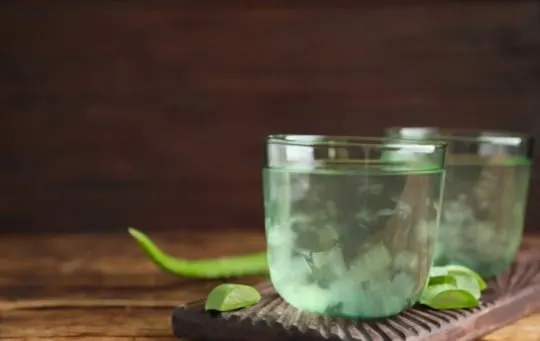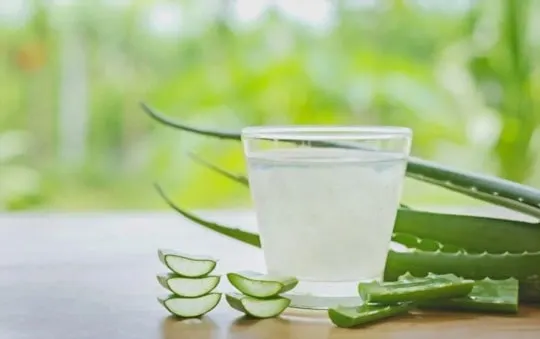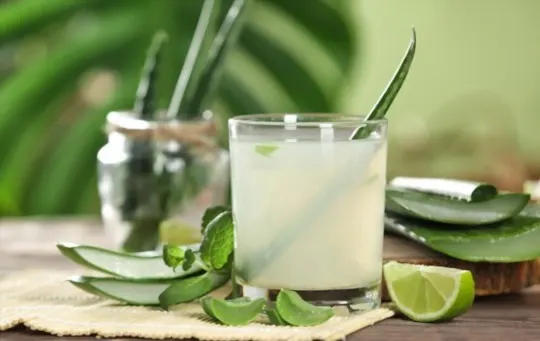It is clear that through thousands of years, various aloe vera products have been used in both medicinal and cosmetics as the base ingredient.
While aloe juice is quite popular in most countries, this plant species is believed to have originated in the Middle East, Arabia to be precise.
Drinking aloe juice may not be the most delicious sip you’ve had in your life, but rest assured, it will be one of the healthiest.
But if you’ve never tasted aloe juice, and you’re wondering, “what does aloe juice taste like?” We’re here to help.
Keep reading as we delve deeper into its taste profile, explain what aloe juice really is, and how to cook and serve it.
What is Aloe Juice?

Aloe juice is simply a juice made using the cactus-type plant aloe vera, which belongs to the Liliacaeae (Asphodelaceae) family.
They have been studied over centuries for their various contributions to human health and well-being.
Even though they originated from the Middle East, today, it is grown in every part of the world and used in homemade or commercial cosmetic or medicinal remedies for various purposes.
Aloe Juice has many health benefits.
It is used as a natural laxative in relieving a constipated state, helps with various gastrointestinal issues you might be facing, and offer various minerals and vitamins that your body needs.
They also have plenty of anti-oxidants that defeat various issues like your deteriorating eye health, and if your cosmetics for clear skin aren’t working, switch to drinking aloe juice.
They keep you hydrated longer and stop any outbreaks from happening.
What Does Aloe Juice Taste Like?

Now that we’re clear on what aloe juice exactly is and how it is essential for our well-being let’s move on to its taste profile.
There are plenty of various supplements or juices marketed as aloe juice, but they may or may not have added extra ingredients.
Always check your macros before you buy them, but the taste could vary depending on the ingredients.
However, if you’re dealing with fresh aloe juice, naturally made at home without any additives except water, it will usually taste bitter.
But there is a way to make it less bitter.
Since aloe contains a residue between the skin and the jelly, this residue is responsible for the bitter aftertaste.
Once you remove the gel from the skin and rinse it off with water, aloe has an extremely mild bitterness to it and will taste more neutral.
Even though it’s homemade, people usually add water to give it a more sweet taste and add other ingredients to the mixture.
Putting too much sugar into the mixture will defeat the purpose of consuming a healthy drink.
So make sure to only add in as little as possible to reap the full benefit of the plant.
How to Cook and Serve Aloe Juice?

The only thing you need to do to make and serve yourself some aloe juice is to buy the plant.
We only need a couple of leaves to make sure we have enough to drink.
Start by cutting up the leaves in a nonfashion manner.
It doesn’t have to be perfect if you take most of the gel out.
Throw the cover; we don’t need them.
Ensure you wash off the gel before putting them in the blender.
As we’ve mentioned, the residue is the reason why aloe is bitter.
Once you’ve successfully made the incisions, and washed off the gel, put them in a blender and add water.
The washing ensures a tasteless aloe like water.
It’d be like drinking water but reaping the full benefits of the plant.
However, you can also choose to enhance its taste profile by adding various high-quality ingredients.
But drinking this type of bland aloe juice may not be for everyone, so putting the juice in a cup and letting it cool inside the refrigerator after you’re done making it, is a great choice.
You now have two choices, drink the chilled aloe juice as it is or you can pour the aloe juice over your favorite beverage enhancing the flavors as well as reaping the full benefits.
That said, a word of caution, it is always better to drink aloe juice in moderation because it can get messy by causing issues that can lead to serious health problems.
Less serious side effects of drinking aloe juice in excess would be diarrhea and cramps.
Conclusion
Aloe juice is a very popular drink not only because of its great health benefits but also for its easy-to-blend attribute.
It is indeed more popular among Asian countries like Japan, India, and South Korea, but it is not limited to them.
Today aloe juice is a popular drink in almost every part of the world.
Aloe juice has a lot of variations as well, but as long as you use high-quality ingredients and mix all of it in moderation, it could be your next favorite beverage.
We hope this article answers all your queries.

What Does Aloe Juice Taste Like? Does it Taste Good?
Ingredients
- Aloe juice
- Ingredients from your favorite recipes
Instructions
- Depending on the ingredients used, the cooking method, and the type of dish, the taste of the food can vary greatly.
- Make sure to select a recipe that will elevate the food’s original flavor, and enjoy experimenting with different recipes!

Andrew Gray is a seasoned food writer and blogger with a wealth of experience in the restaurant and catering industries. With a passion for all things delicious, Andrew has honed his culinary expertise through his work as a personal chef and caterer.
His love for food led him to venture into food writing, where he has contributed to various online publications, sharing his knowledge and insights on the culinary world. As the proud owner of AmericasRestaurant.com, Andrew covers a wide range of topics, including recipes, restaurant reviews, product recommendations, and culinary tips.
Through his website, he aims to inspire and educate fellow food enthusiasts, offering a comprehensive resource for all things food-related.

Leave a comment